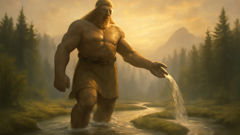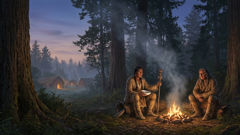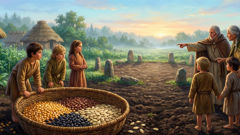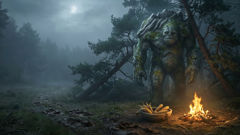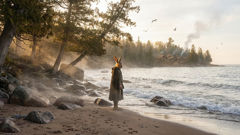Introduction
In the dawn-lit mists of ancient Estonia, when the forests stretched endless and deep, and the rivers wound like silver ribbons through untouched land, there was a time when legends walked alongside mortals and the world was shaped by hands both gentle and mighty. Of all the tales whispered beneath wind-bowed pines and sung beside crackling hearths, none carries the strength or sorrow of Kalevipoeg, the giant son of Kalev and Linda, whose shadow still lingers in the stones and valleys of his homeland. Born larger than any man and marked by fate, Kalevipoeg grew up under the watchful eyes of a nation awaiting a hero. From his earliest steps, the ground trembled, and his laughter echoed across the bogs and hills. He learned not only the language of men but the secrets of birds, the wisdom of wind, and the mysteries held in the roots of ancient oaks. Where others saw obstacles, he saw opportunities—turning rivers with his hands, lifting boulders that became islands, and forging paths through dark forests for those who would come after. Yet for all his strength, Kalevipoeg’s journey was never a simple one. He was called to defend his people from threats both natural and magical, to outwit sorcerers and rival kings, and to bear the burden of destiny with courage and sacrifice. His travels stretched from the rocky shores of the Baltic Sea to the shadowy borders of the Underworld, each adventure etching itself into the memory of the land. As he journeyed, he shaped not just the terrain but the very spirit of Estonia—a spirit of resilience, hope, and unbreakable will. This is the story of Kalevipoeg: a legend carved in stone, sung by the wind, and cherished by generations. To follow his path is to walk the backbone of a nation and to glimpse the enduring soul of a people woven from myth, courage, and the wild beauty of their homeland.
The Making of a Hero: Kalevipoeg’s Origins and Trials
In the heart of a land draped in fog and stories, Kalevipoeg was born to Kalev, a wise chieftain, and Linda, a woman whose beauty was matched only by her kindness. From his first breath, it was clear he belonged not only to his parents but to all of Estonia. His cradle was a hollowed-out oak trunk, his lullabies the calls of cranes and whisper of birch leaves. Even as a child, he could toss stones farther than grown men and run as swift as the northern wind. His laughter sent flocks of birds fluttering from the reeds, and his tears—on the rare occasions they fell—watered wildflowers on the hillsides.
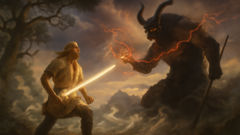
As he grew, so did his strength, but also his sense of duty. Kalevipoeg watched as raiders threatened the peace of his people and as sorcerers from distant lands schemed in the shadows. Under Linda’s gentle guidance, he learned compassion, respect for the land, and the price of power. From his father, he inherited wisdom and a fierce determination to protect those who could not protect themselves. But it was loss that would forge his courage: When his father passed into legend, Kalevipoeg took up the mantle of leadership, vowing to guard Estonia against darkness—no matter the cost.
The young giant soon found his courage tested. News arrived of an evil sorcerer, Sarvik, whose magic brought blight and hunger to the countryside. Crops withered, rivers dried, and fear crept into every village. Armed with his father’s blade—a sword forged from star-iron and tempered in the tears of the moon—Kalevipoeg set out to confront Sarvik. The path was perilous. In the ancient bogs, spirits whispered secrets and riddles; in the tangled forests, wolves with eyes like embers watched from the shadows. Yet Kalevipoeg pressed on, never faltering.
His first encounter with Sarvik was fierce. The sorcerer unleashed storms of fire and illusions that turned day to night. But the hero’s strength was more than muscle; he remembered his mother’s words—true power lay in understanding, not just in force. He listened to the wind, deciphered the tricks hidden in the flames, and with a thunderous roar, he shattered Sarvik’s staff and drove him back into the darkness. Yet Sarvik was not defeated, only scattered—his threat lingering like fog over the land.
Returning home, Kalevipoeg discovered that victory brought as many burdens as defeat. The people rejoiced, but the land was scarred, and peace was fleeting. His mother, Linda, weary from worry and loss, passed away as she wept for her people. In her sorrow, she dropped great stones as she traveled, forming the hills and lakes that now mark Estonia’s heart. Kalevipoeg mourned deeply but found in his grief a new resolve—to honor Linda’s memory by healing the land and uniting its people. Thus began his journey not just as a defender but as a builder, shaping rivers with his hands, moving mountains to protect villages, and sowing hope where despair once grew.
Journeys Across the Land: Shaping Estonia and Facing Peril
With each stride across Estonia, Kalevipoeg left more than footprints—he left legends etched into the very landscape. Where he knelt to drink from a brook, lakes blossomed in his wake. When he cleared paths for weary travelers, those routes became the roads that would later connect villages. In moments of sorrow, when memories of his parents weighed heavy, he would lift massive stones and set them in circles—these became ancient resting places, silent witnesses to the hero’s grief and resolve.
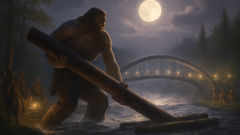
But shaping the land was not his only calling. Word spread of Kalevipoeg’s deeds, and with it came both gratitude and envy. Neighboring kings viewed him as a rival, sending envoys with impossible challenges. One demanded he build a bridge over the wild Emajõgi River in a single night; another sought to trick him with riddles about the stars. Ever resourceful, Kalevipoeg replied to strength with strength, and to cunning with wit. The bridge over Emajõgi was built not of wood or stone but of the trunks of ancient trees he pulled from the earth, woven together by moonlight and sealed by his own promise. When faced with riddles, he remembered the lessons hidden in the songs of birds and the patterns of moss on tree trunks—solving each puzzle and earning respect even from his enemies.
Yet danger always lurked nearby. The sorcerer Sarvik, though battered, plotted revenge from his hidden lair deep beneath the roots of Estonia’s oldest forests. Disguised as a wandering merchant, he tried to trick Kalevipoeg with enchanted objects—cursed boots that would carry him to the edge of the world, a silver harp whose music lured travelers into swamps. Each time, Kalevipoeg saw through the deception, though not without cost. On one occasion, he lost his way for days in a haunted forest, guided out only by the soft glow of a blue-flowering plant his mother once cherished.
As seasons turned, Kalevipoeg gathered allies. Loyal friends joined his journey: Alevipoeg, quick-witted and agile; Sulevipoeg, as strong as a bear; and Olevipoeg, whose laughter could drive away fear. Together, they faced monsters born from nightmare and envy—giant wolves with steel jaws, rivers haunted by sorrowful maidens, and stone men who guarded forgotten treasures. Each challenge brought new scars but also deeper bonds of trust.
The people flourished wherever Kalevipoeg passed. Villages grew in places where he cleared the land, and farmers blessed the stones he placed, believing them to carry a fragment of the giant’s enduring strength. The forests, once feared for their darkness and wildness, became places of hope, filled with birdsong and promise. Yet always, Kalevipoeg felt the weight of destiny urging him forward—toward adventures yet untold and sacrifices yet unimagined.
To the Edge of the World: Sorcery, Sacrifice, and Kalevipoeg’s Fate
As Kalevipoeg’s legend grew, so did the trials he faced. Tales of his might spread beyond Estonia’s borders, reaching distant lands where other giants, witches, and spirits grew restless. One storm-tossed night, as he rested atop a hill overlooking a lake he himself had shaped, a vision came to him in his dreams: a warning that Sarvik had not been destroyed but had opened a gateway to the Underworld, threatening to unleash chaos upon all of creation.
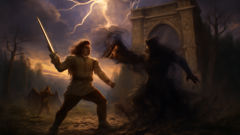
He awoke with purpose burning in his heart. Calling his friends and gathering the bravest warriors from across the land, Kalevipoeg set out toward the ancient gates said to lie deep within the haunted Soomaa bogs. The journey was fraught with peril. Deadly mists coiled around their ankles, and voices of the lost whispered from every twisted tree. Many warriors turned back, overcome by fear or led astray by phantom lights. Only the most steadfast pressed on, guided by Kalevipoeg’s booming voice and unwavering courage.
Reaching the gates, they found Sarvik waiting, his power now swollen by darkness. The battle that followed shook the earth. Lightning cracked overhead, and the ground split open to reveal chasms filled with writhing shadows. Kalevipoeg fought with every ounce of strength—his sword flashing like a shooting star. Friends fell at his side, their sacrifices etching new resolve into the hero’s soul. At last, with a cry that echoed for miles, Kalevipoeg drove Sarvik back into the abyss, sealing the gateway with a massive stone.
But victory came at a terrible cost. As Kalevipoeg placed the last stone, a curse woven by Sarvik lashed out—a fatal enchantment triggered by the sword he carried. Bound by fate, Kalevipoeg could not set foot beyond the gates of the Underworld without losing his life. Realizing this, he turned back, but as he stepped over the threshold, the ground rose up like a living thing, ensnaring his feet in iron roots. With one last effort, he hurled his sword into the sky, where it became a constellation, shining over Estonia to guide future generations.
Trapped between worlds, Kalevipoeg called out not for rescue but for hope—that his people would remember his story, honor the land he shaped, and protect it from darkness. His friends wept but carried his message home. Where his tears fell, new rivers flowed; where his laughter once rang, wildflowers bloomed. In time, villagers noticed a figure at dusk or dawn—a giant shape on the horizon, silently watching over them. Some say it is Kalevipoeg’s spirit, guarding Estonia until the world’s end. His tale became not just a memory but a promise: that courage and sacrifice can shape nations and that every stone and river in Estonia holds a fragment of his soul.
Conclusion
Kalevipoeg’s story is more than a tale of strength or daring; it is the living heartbeat of Estonia itself. In every rolling hill, every shimmering lake, and every moss-clad stone, echoes of his journey remain—a constant reminder that the landscape is as much a tapestry of memory as it is of earth and water. The people he loved and protected flourished in the shelter of forests he once shaped, their songs and stories growing richer with each generation. The rivers he carved flow on, nurturing fields and dreams alike, while villages still gather around ancient stones, whispering thanks to their unseen guardian.
Though bound by fate to the threshold between worlds, Kalevipoeg’s spirit endures wherever courage is needed—whenever a child stands up for justice or a community unites in hope. His sacrifices remind all who hear his story that true greatness lies not only in power but in compassion and resilience. The curse that trapped him became a blessing for his people, for it forged an unbreakable bond between hero and homeland. As dusk settles over Estonia’s wild landscapes, some still glimpse a giant’s shadow watching from afar—a silent promise that Kalevipoeg’s heart beats on in every stone and story. Through his epic, Estonia found not only a champion but a soul—a reminder that legends live on wherever people cherish the land and strive for courage in the face of darkness.

